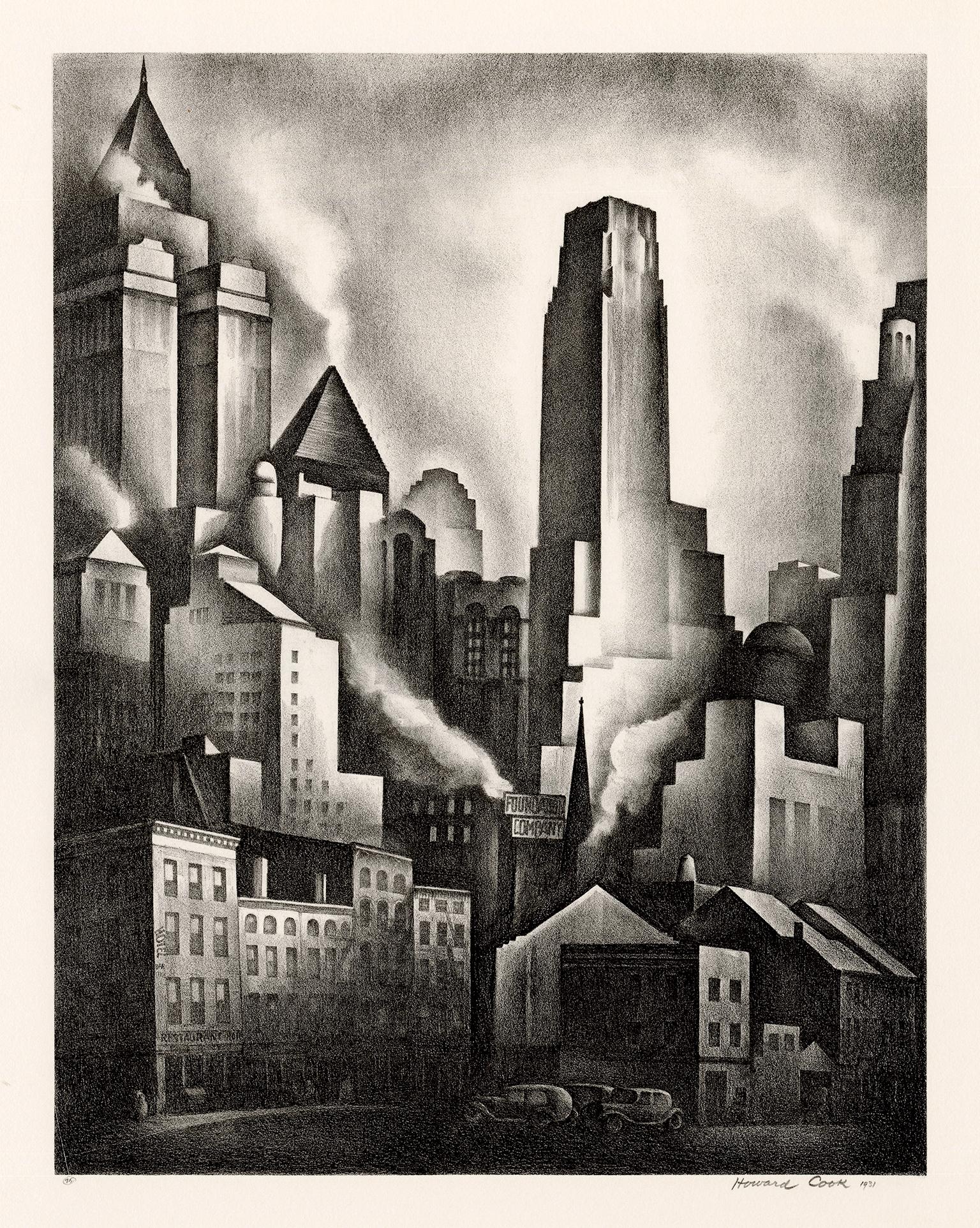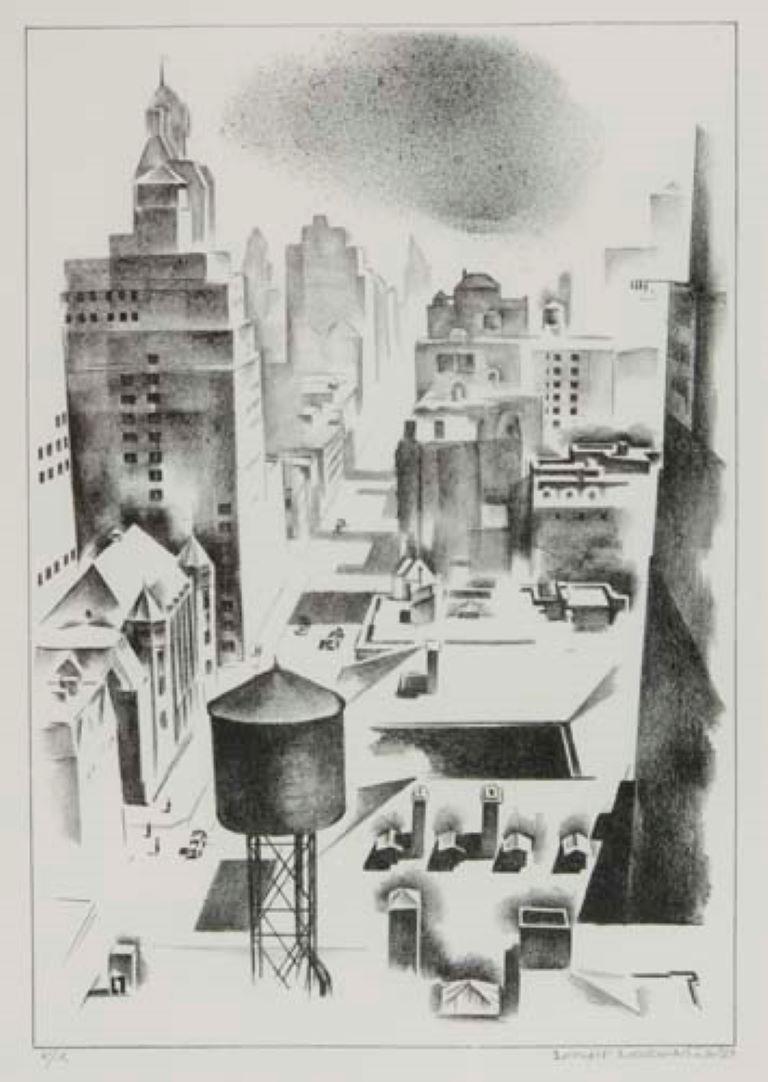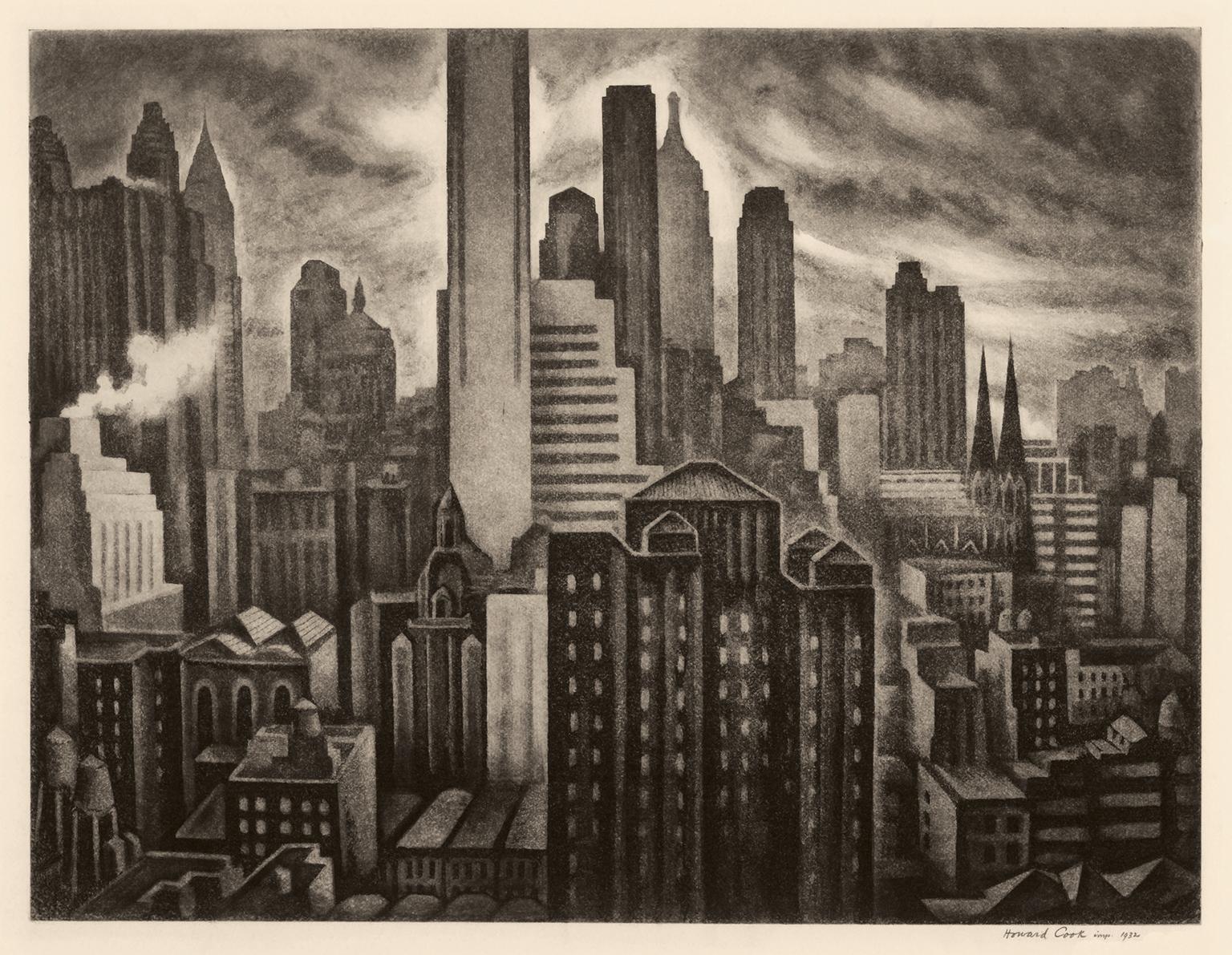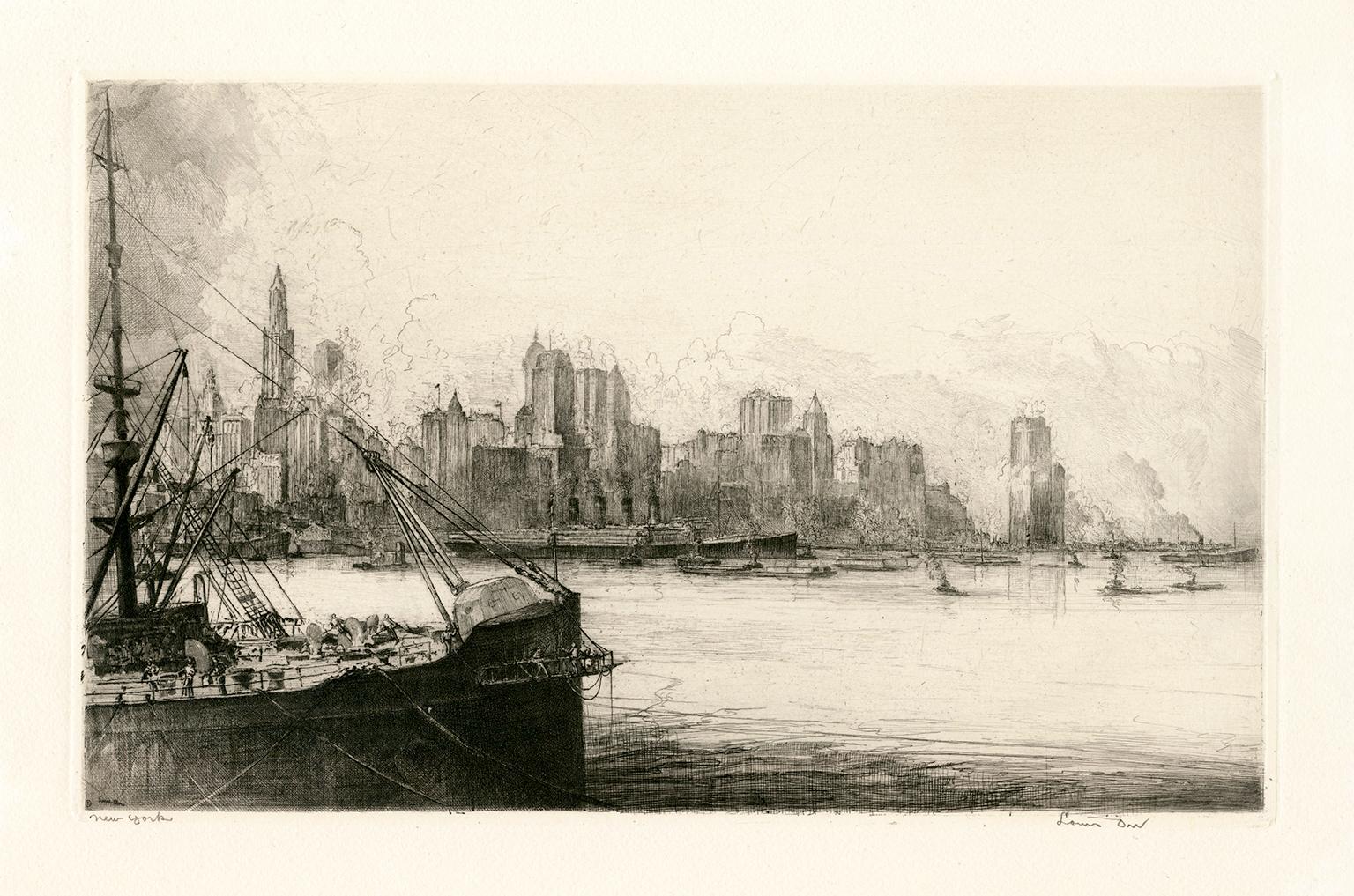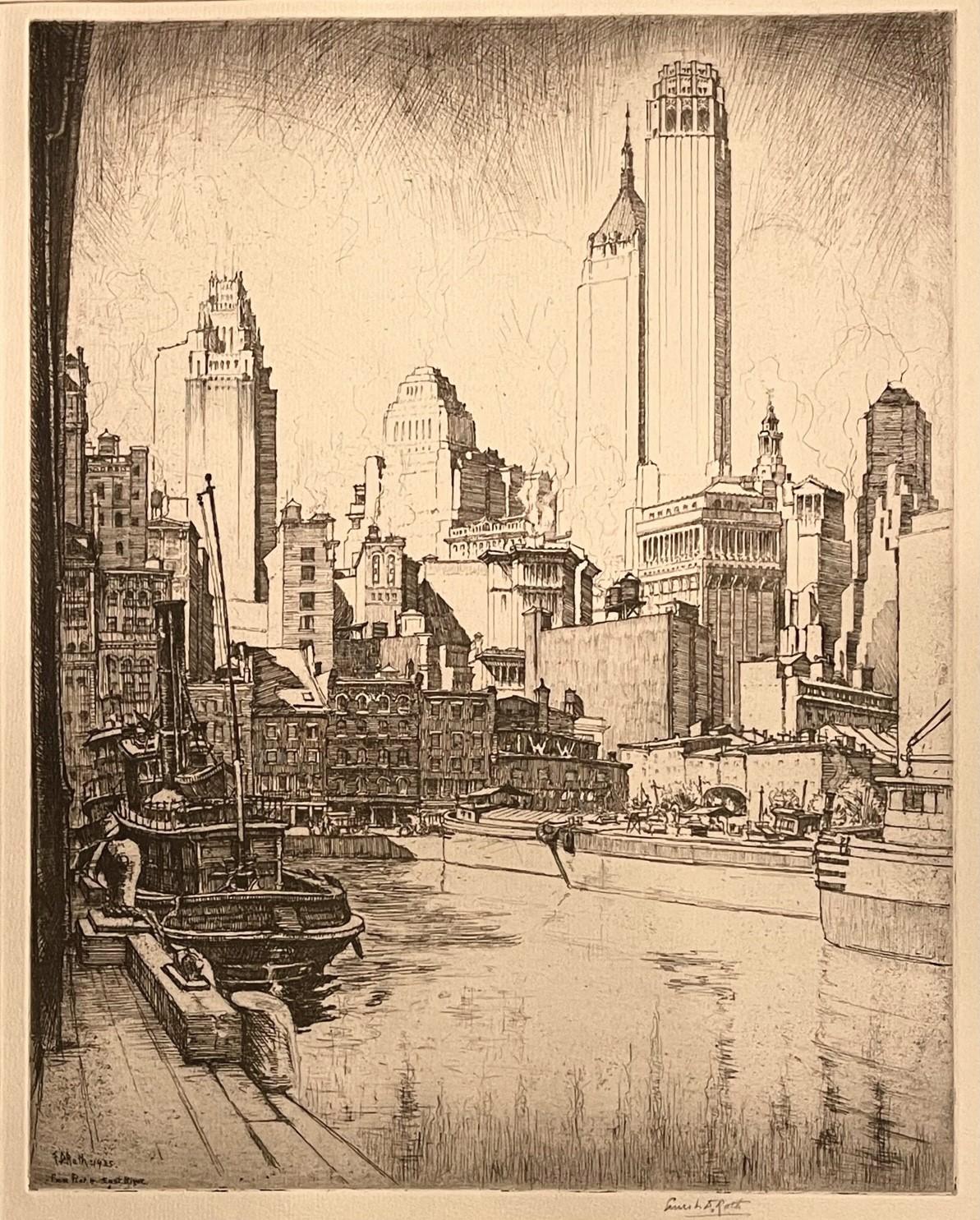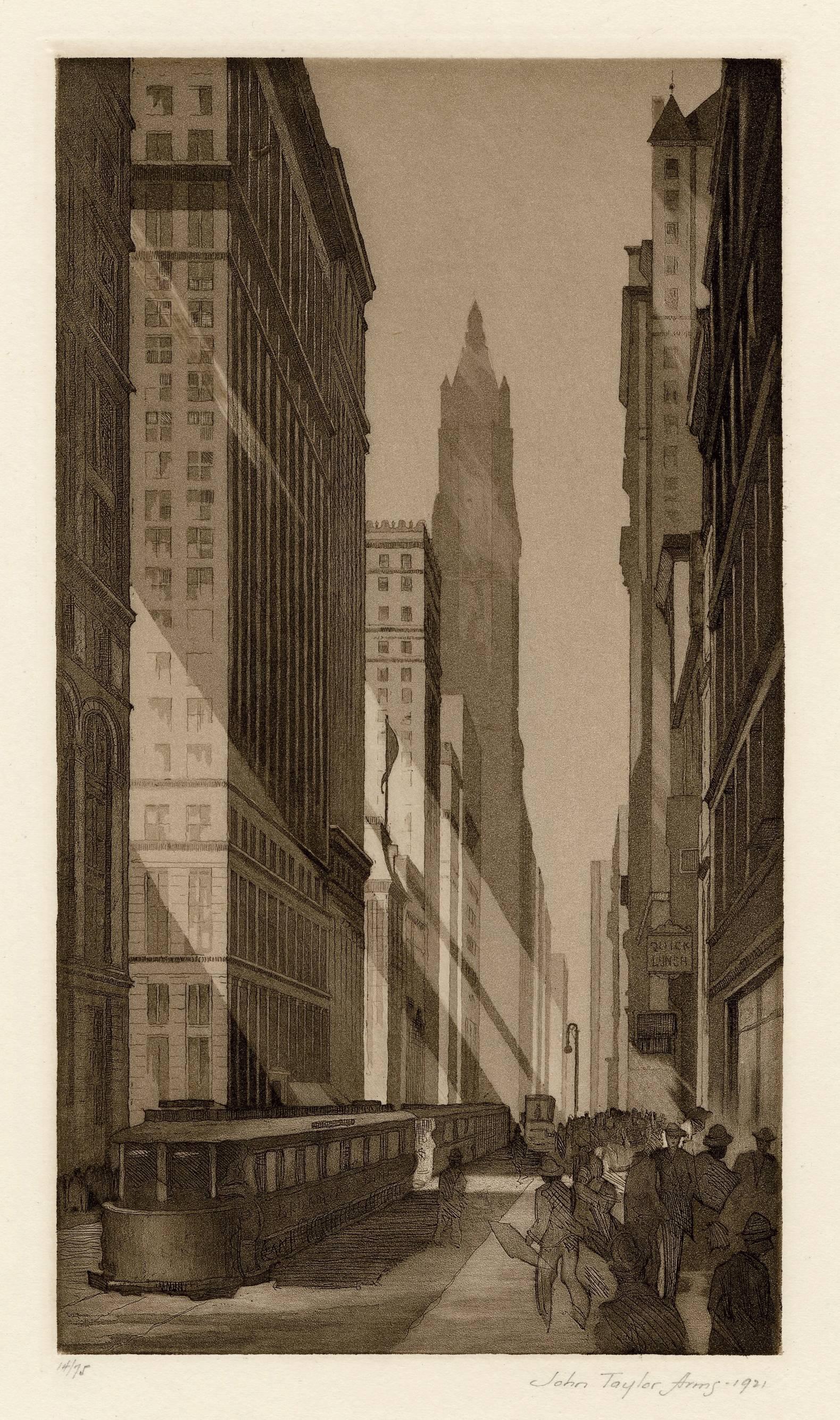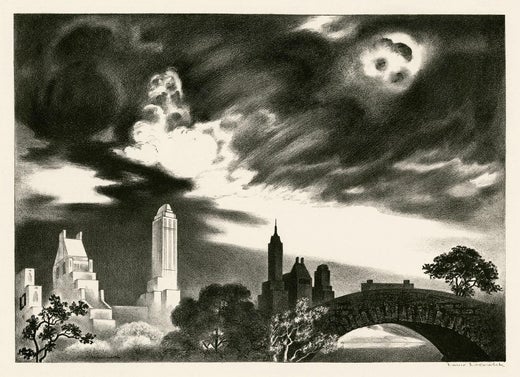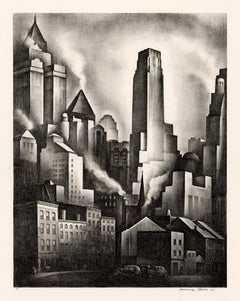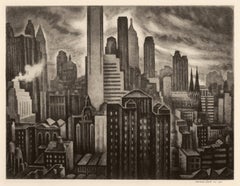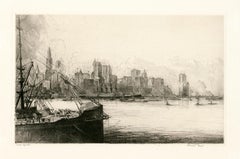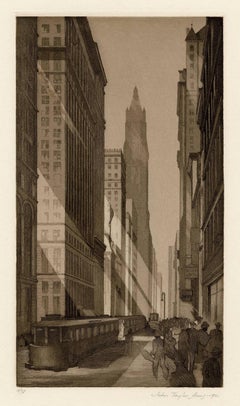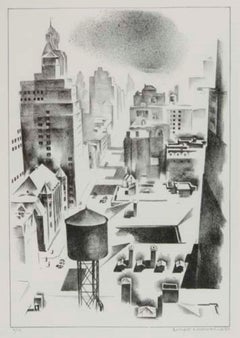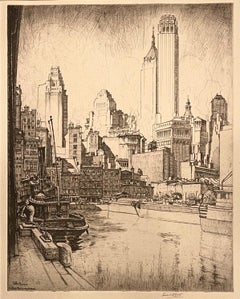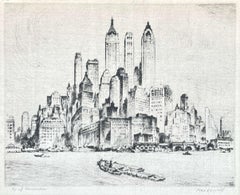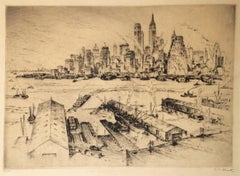Items Similar to 'Mural Study: Lower Manhattan' — WPA Era Precisionism
Want more images or videos?
Request additional images or videos from the seller
1 of 3
Louis Lozowick'Mural Study: Lower Manhattan' — WPA Era Precisionism1935
1935
$22,000
£16,602.80
€19,007.69
CA$31,027.29
A$34,064.10
CHF 17,771.31
MX$412,223.02
NOK 222,735.83
SEK 209,875.71
DKK 141,887.33
About the Item
Louis Lozowick, 'Mural Study: Lower Manhattan', lithograph, edition 10 or fewer, 1936. Flint 135. Signed and dated in pencil. Signed in the stone, lower right.
A fine, richly-inked impression, on cream, wove paper with full margins ( 1 1/2 to 2 3/8 inches), in excellent condition. Signed and dated '36 in pencil. Printed by master lithographer Theodore Cuno. Extremely rare. Archivally matted to museum standards, unframed.
Image size 13 5/16 x 7 3/16 inches (338 x 182 mm); sheet size 17 1/8 x 11 3/8 inches (435 x 289 mm).
ABOUT THIS WORK
This historical image is Lozowick’s study for one of a pair of murals commissioned by the Treasury Relief Art Project for the Post Office at 33rd Street and 8th Avenue in New York City. The 107-year-old James A. Farley Building has now been converted into an extension of Pennsylvania Station—a grand train hall for passengers of Amtrak and the Long Island Rail Road.
Impressions of this lithograph are in the permanent collections of the following institutions: Iowa State University Museum, Smithsonian American Art Museum, U.S. Treasury Collection, Wolfsonian (Florida International University).
ABOUT THE ARTIST
Born in Russia in 1892, Lozowick came to this country at the age of 14 to join his brother in New York City. By 1919 he had attended art school, finished college, served in the army, and traveled throughout the United States visiting major cities which would later become subjects of his work. From 1919 to 1924 Lozowick lived and traveled throughout Europe, staying in Paris, Berlin, and Moscow. In 1920 he began his Machine Age drawings, the ‘Machine Ornament’ series and three years later he made his first print.
Having assimilated European Constructivist and Cubist theories, and the Bauhaus manifesto promoting the integration of applied and fine art, Lozowick was inspired to present the rapidly growing New York City skyline with its monumental skyscrapers as modern symbols of optimism. Like many other Depression-era artists, he identified closely with the common worker and valued the exacting craft and artisanship dictated by the printmaking process. His versatility and range of interests were exemplified by his stage sets for the 1926 production of Georg Kaiser’s play “Gas,” the first Constructivist production seen in America. A year later, his images and essay were centerpieces in the pivotal 1927 Machine Age Exposition in New York.
Assigned to the WPA New York Graphic Arts Division in 1935, he left in 1936 to accept a commission from the prestigious Treasury Relief Art Project for two large oil paintings for the Post Office at 33rd Street in Manhattan. The featured work above, 'Mural study: Lower Manhattan,' is one of his two preliminary lithographic studies for these striking murals.
Returning to the Project in 1938, Lozowick continued to experiment with various printmaking mediums, including wood engraving, drypoint, and screen printing, until the end of his appointment in 1940. During the next three decades, encouraged by curator Carl Zigrosser of the Weyhe Gallery, he devoted himself primarily to lithography, mounting several solo exhibitions at major New York galleries, and a retrospective at the Whitney Museum of American Art in 1972.
Louis Lozowick is widely recognized as a key figure in America's Precisionist movement and a leader in mid-20th-century modernist printmaking. His graphic works and paintings have been acquired by numerous museums, including the Art Institute of Chicago, Brooklyn Museum, Crystal Bridges Museum of American Art, Fine Arts Museums of San Francisco, Metropolitan Museum of Art, Museum of Modern Art, New York Public Library, Philadelphia Museum of Art, Smithsonian American Art Museum, U. S. Library of Congress, and the Whitney Museum of American Art.
- Creator:Louis Lozowick (1892 - 1973, American)
- Creation Year:1935
- Dimensions:Height: 12.82 in (32.57 cm)Width: 8.88 in (22.56 cm)
- Medium:
- Movement & Style:
- Period:
- Condition:
- Gallery Location:Myrtle Beach, SC
- Reference Number:Seller: 1036321stDibs: LU53233889772
Louis Lozowick
Louis Lozowick is widely recognized as a key figure in America's Precisionist movement and a leader in mid-20th-century modernist printmaking. His graphic works and paintings have been acquired by numerous museums including the Art Institute of Chicago, Brooklyn Museum, Crystal Bridges Museum of American Art, Fine Arts Museums of San Francisco, Metropolitan Museum of Art, Museum of Modern Art, New York Public Library, Philadelphia Museum of Art, Smithsonian American Art Museum, U. S. Library of Congress and the Whitney Museum of American Art.
About the Seller
5.0
Recognized Seller
These prestigious sellers are industry leaders and represent the highest echelon for item quality and design.
Platinum Seller
Premium sellers with a 4.7+ rating and 24-hour response times
Established in 1995
1stDibs seller since 2016
321 sales on 1stDibs
Typical response time: 1 hour
Associations
International Fine Print Dealers Association
- ShippingRetrieving quote...Shipping from: Myrtle Beach, SC
- Return Policy
Authenticity Guarantee
In the unlikely event there’s an issue with an item’s authenticity, contact us within 1 year for a full refund. DetailsMoney-Back Guarantee
If your item is not as described, is damaged in transit, or does not arrive, contact us within 7 days for a full refund. Details24-Hour Cancellation
You have a 24-hour grace period in which to reconsider your purchase, with no questions asked.Vetted Professional Sellers
Our world-class sellers must adhere to strict standards for service and quality, maintaining the integrity of our listings.Price-Match Guarantee
If you find that a seller listed the same item for a lower price elsewhere, we’ll match it.Trusted Global Delivery
Our best-in-class carrier network provides specialized shipping options worldwide, including custom delivery.More From This Seller
View All'Financial District', New York City — American Modernism
By Howard Norton Cook
Located in Myrtle Beach, SC
Howard Cook, 'Financial District', lithograph, 1931, edition 75, Duffy 155. A fine, richly-inked impression, on cream wove paper, the full sheet with wide margins (2 3/4 to 5 5/8 inches), in excellent condition. Image size 13 5/16 x 10 3/8 inches (338 x 264 mm); sheet size 23 x 16 inches (584 x 406 mm). Matted to museum standards, unframed.
Literature: 'American Master Prints from the Betty and Douglas Duffy Collection', the Trust for Museum Exhibitions, Washington, D.C., 1987.
Collections: Crystal Bridges Museum of American Art, Library of Congress, Metropolitan Museum of Art, Philadelphia Museum of Art, Smithsonian American Art Museum.
ABOUT THE ARTIST
Howard Norton Cook (1901-1980) was one of the best-known of the second generation of artists who moved to Taos. A native of Massachusetts, he studied at the Art Students League in New York City and at the Woodstock Art Colony. Beginning his association with Taos in 1926, he became a resident of the community in the 1930s. During his career, he received two Guggenheim Fellowships and was elected an Academician in the National Academy of Design. He earned a national reputation as a painter, muralist, and printmaker.
Cook’s work in the print mediums received acclaim early in his career with one-person exhibitions at the Denver Art Museum (1927) and the Museum of New Mexico (1928). He received numerous honors and awards over the years, including selection in best-of-the-year exhibitions sponsored by the American Institute of Graphics Arts, the Brooklyn Museum, the Society of American Etchers, and the Philadelphia Print Club. His first Guggenheim Fellowship took him to Taxco, Mexico in 1932 and 1933; his second in the following year enabled him to travel through the American South and Southwest.
Cook painted murals for the Public Works of Art Project in 1933 and the Treasury Departments Art Program in 1935. The latter project, completed in Pittsburgh, received a Gold Medal from the Architectural League of New York. One of his most acclaimed commissions was a mural in the San Antonio Post Office in 1937.
He and Barbara Latham settled in Talpa, south of Taos, in 1938 and remained there for over three decades. Cook volunteered in World War II as an Artist War Correspondent for the US Navy, where he was deployed in the Pacific. In 1943 he was appointed Leader of a War Art Unit...
Category
1930s American Modern Figurative Prints
Materials
Lithograph
'Soaring New York' — 1930s American Modernism, New York City
By Howard Norton Cook
Located in Myrtle Beach, SC
Howard Cook, 'Soaring New York', aquatint, soft-ground etching, roulette, 1931-32, edition 25, Duffy 165. Signed, dated, and annotated 'imp' in pencil. A superb, richly-inked, atmosp...
Category
1930s American Modern Figurative Prints
Materials
Etching, Aquatint
New York (from Ports of America)
By Louis Orr
Located in Myrtle Beach, SC
Louis Orr, 'New York' (from the portfolio 'Ports of America', published by Yale University Press, 1928), etching, 1925, edition not stated. Signed and titled in pencil. Signed in the...
Category
1920s Realist Landscape Prints
Materials
Etching
'Downtown, New York' — 1920s Modernism
By John Taylor Arms
Located in Myrtle Beach, SC
John Taylor Arms, 'Downtown, New York', etching with aquatint, 1921, edition 75, Fletcher 108. Signed, dated, and numbered 14/75 in pencil.
A superb, finely nuanced impression, in d...
Category
Early 20th Century American Modern Landscape Prints
Materials
Etching
'Woolworth Building Under Construction' — Early 20th Century Modernism
By Earl Horter
Located in Myrtle Beach, SC
Earl Horter, 'The Woolworth Building Under Construction', etching, c. 1912, edition not stated. Signed in pencil. A fine, richly-inked impression, in warm black ink, with selectively...
Category
1910s American Modern Landscape Prints
Materials
Etching
'New York, Central Park' — 1930s American Modernism
By William Meyerowitz
Located in Myrtle Beach, SC
'New York, Central Park', etching, edition 40, c. 1930. Signed in pencil. Titled and numbered '14/40' on the bottom sheet edge, in pencil. Signed in the plate, lower left. A superb, ...
Category
1930s American Modern Landscape Prints
Materials
Etching
You May Also Like
Madison Avenue
By Louis Lozowick
Located in New York, NY
An excellent impression of this extremely rare, early lithograph. This is the second edition (of two) and is signed, dated and numbered in pencil by Lozowick. Printed by Burr Miller,...
Category
1920s Art Deco Landscape Prints
Materials
Lithograph
FROM PIER 4 - EAST RIVER
By Ernest David Roth
Located in Portland, ME
Roth, Ernest (American, 1879-1964). FROM PIER 4 - EAST RIVER. Etching, not dated. Edition size not stated. Signed in Pencil, and titled in pencil at the lower edge, and Signed, dated...
Category
Mid-20th Century Landscape Prints
Materials
Etching
A ca. 1940 Etching Titled "Tip of Manhattan" by Artist Nat Lowell
By Nat Lowell
Located in Chicago, IL
A ca. 1940 etching of a view of the Manhattan skyline by artist Nat Lowell. Signed and titled in pencil, ca. 1940. Artworks size: 4 1/4" x 5 1/4". Arc...
Category
1940s American Modern Landscape Prints
Materials
Etching, Paper
MANHATTAN
By Anton Schutz
Located in Santa Monica, CA
ANTON SCHUTZ
MANHATTAN c 1940
Etching, signed in pencil, edition 100, no. 15/100. On thin simili-japan paper. Very slight toning around plate mark. Remnants of old tape on verso, s...
Category
1940s American Realist Landscape Prints
Materials
Etching
New York Skyline
By Louis H. Ruyl
Located in Middletown, NY
Etching with drypoint on cream wove paper with deckle edges, 4 3/8 x 12 3/4 inches (233 x 323 mm); sheet 9 1/2 x 15 3/4 inches (240 x 338 mm), full margins. Signed and numbered 4/75 ...
Category
Early 20th Century American Modern Landscape Prints
Materials
Handmade Paper, Etching, Drypoint
Financial District
By Howard Norton Cook
Located in New York, NY
Howard Cook (1901-1980), Financial District, lithograph, 1931, signed and dated in pencil lower right and numbered 75 lower left. Reference: Duffy 155, from the stated edition of 75....
Category
1930s American Modern Landscape Prints
Materials
Lithograph
